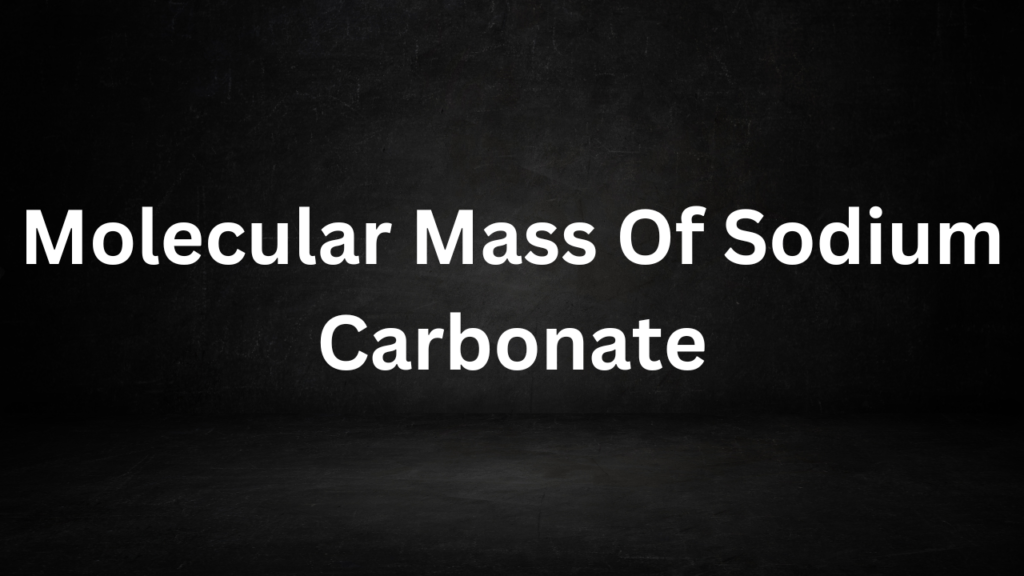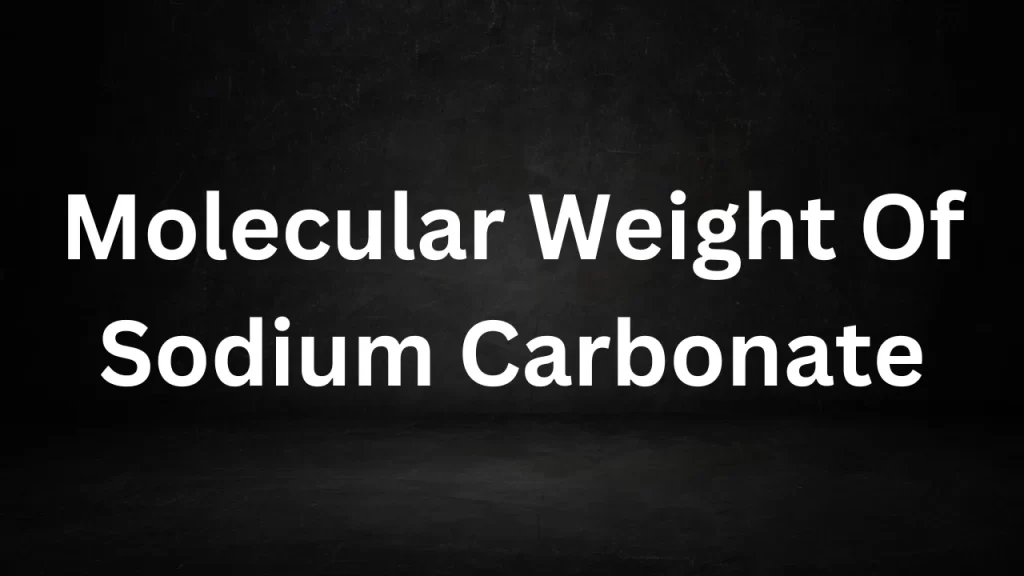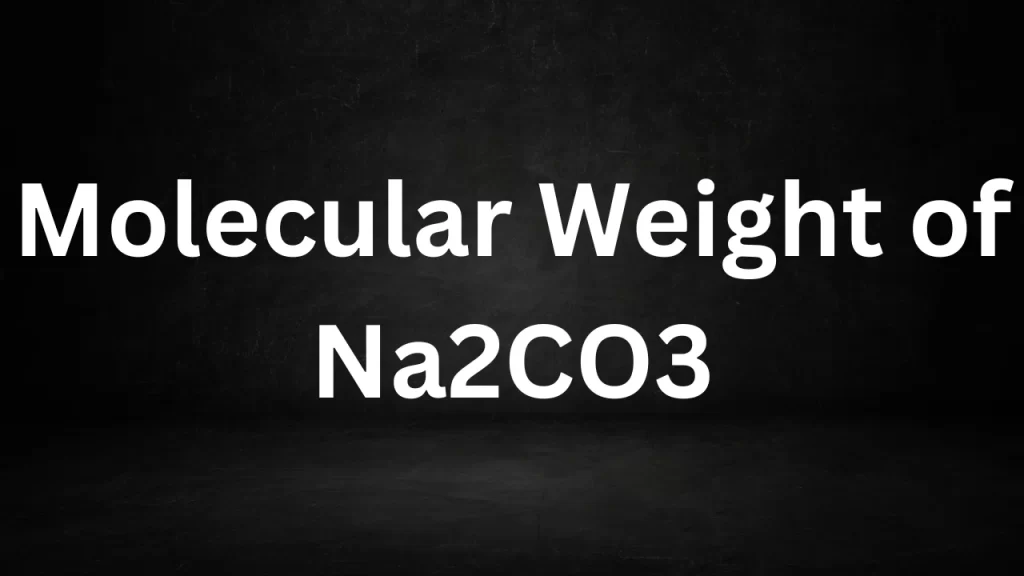Tag: anhydrous sodium carbonate molecular weight
Molecular Mass Of Sodium Carbonate
Molecular Mass Of Sodium Carbonate: Sodium carbonate, also known as soda ash or washing soda, is a versatile chemical compound with numerous applications, ranging from household cleaning to industrial processes.
In the field of chemistry, understanding the mole mass of sodium carbonate plays a pivotal role in various calculations, especially those related to chemical reactions, stoichiometry, and solution preparations. In this article, we’ll explore molar mass, its significance in chemistry, and calculate the molar mass of sodium carbonate (Na2CO3).

Molecular Mass Of Sodium Carbonate
Molecular Mass: A Foundational Concept
The Molecular mass, also referred to as mole weight or molar mass, is a fundamental concept in chemistry. It denotes the mass of a single mole of a substance, commonly expressed in atomic mass units (amu) or unified atomic mass units (u). To calculate the molar mass of a compound, add the atomic masses of all its constituent atoms, considering their relative proportions.
Calculating the Molecular Mass of Sodium Carbonate
To calculate the mole mass of sodium carbonate (Na2CO3), we must first determine the atomic masses of the elements: sodium (Na), carbon (C), and oxygen (O), and then apply these values to the chemical formula.
- Sodium (Na): The atomic mass of sodium is approximately 22.99 amu.
- Carbon (C): The atomic mass of carbon is approximately 12.01 amu.
- Oxygen (O): The atomic mass of oxygen is approximately 16.00 amu.
Now, let’s calculate the molecular mass of sodium carbonate:
Molecular Mass of Na2CO3 = (2 × Atomic Mass of Na) + (1 × Atomic Mass of C) + (3 × Atomic Mass of O)
The Molecular Mass of Na2CO3 = (2 × 22.99 amu) + (1 × 12.01 amu) + (3 × 16.00 amu)
Molecular Mass of Na2CO3 = 45.98 amu + 12.01 amu + 48.00 amu
Molecular Mass of Na2CO3 = 105.99 amu
So, the molecular mass of sodium carbonate (Na2CO3) is approximately 105.99 amu.
Significance of Molecular Mass of Sodium Carbonate
The mole mass of sodium carbonate holds significant importance in various aspects of chemistry:
- Stoichiometry: Mole mass is crucial in stoichiometry, allowing chemists to balance chemical equations and determine the quantities of reactants and products involved in chemical reactions with sodium carbonate.
- Solution Preparation: In laboratories and industries, knowledge of the mole mass is essential for accurately preparing sodium carbonate solutions with specific concentrations, ensuring precise measurements.
- Industrial Applications: Sodium carbonate is widely used in industries such as glass manufacturing, detergents, and water treatment. Understanding its mole mass is vital for quality control and process optimization.
- Household Uses: Sodium carbonate is commonly found in household cleaning products, and its mole mass can help consumers understand product concentrations and efficacy.
- Safety: Knowing the mole mass of sodium carbonate is essential for handling it safely, especially in industrial and laboratory settings, as it assists in determining appropriate safety protocols and precautions.
Conclusion
The mole mass of sodium carbonate (Na2CO3) is a fundamental concept in chemistry, holding practical importance in various applications. Finding molar mass empowers informed choices, precise experiments, and optimized sodium carbonate use in various contexts. Comprehending this essential parameter amplifies our capacity to utilize sodium carbonate’s versatility across diverse chemical processes and applications.
Read More
- Molecular Mass Of Nitric Acid
- Molecular Mass Of Sulphuric Acid
- Molar Mass Of Sulphuric Acid
- Types Of Motion In Physics
- Kinetic Energy Class 9
Frequently Asked Questions (FAQs) On Molecular Mass Of Sodium Carbonate
1. What is the molecular formula of sodium carbonate?
The mole formula of sodium carbonate is Na2CO3, representing two sodium atoms (Na), one carbon atom (C), and three oxygen atoms (O) in a single molecule.
2. What does molecular mass or molar mass mean in chemistry?
Molecular mass, also known as molar mass, refers to the mass of one mole of a substance and is typically expressed in atomic mass units (amu) or unified atomic mass units (u). It is a fundamental concept in chemistry used for various calculations.
3. Why is the molecular mass of sodium carbonate important in chemistry?
The mole mass of sodium carbonate is essential in chemistry because it helps determine the quantity of sodium carbonate involved in chemical reactions, stoichiometry, and solution preparations.
4. How is the molecular mass of sodium carbonate calculated?
To calculate the mole mass of sodium carbonate (Na2CO3), you sum the atomic masses of all the atoms in its chemical formula, taking into account their respective proportions.
5. What is the molecular mass of sodium carbonate (Na2CO3)?
The mole mass of sodium carbonate is approximately 105.99 amu.
Molecular Weight Of Sodium Carbonate
Molecular Weight Of Sodium Carbonate: Sodium carbonate, commonly known as soda ash or washing soda, is a chemical compound with the molecular formula Na2CO3.
Understanding its molecular weight is fundamental in various fields, including chemistry, industry, and environmental science.
In this article, we delve into the concept of molecular weight and explore the significance of knowing the molecular weight of sodium carbonate.

Molecular Weight Of Sodium Carbonate
Definition of Molecular Weight
Molecular weight, also known as molar mass or molecular mass, is a measure of the mass of a molecule. It is defined as the sum of the atomic weights (masses) of all the atoms in a molecule. The unit of molecular weight is the atomic mass unit (amu) or unified atomic mass unit (u). For convenience, molecular weights are often expressed in grams per mole (g/mol).
Calculating the Molecular Weight of Sodium Carbonate
To calculate the molecular weight of sodium carbonate (Na2CO3), we need to sum the atomic weights of all the constituent atoms:
- Sodium (Na) has an atomic weight of approximately 22.99 amu.
- Carbon (C) has an atomic weight of roughly 12.01 amu.
- Oxygen (O) has an atomic weight of about 16.00 amu.
Now, let’s calculate the molecular weight:
Molecular Weight of Na2CO3 = (2 * Atomic Weight of Na) + Atomic Weight of C + (3 * Atomic Weight of O)
Molecular Weight of Na2CO3 = (2 * 22.99 amu) + 12.01 amu + (3 * 16.00 amu)
Mole Weight of Na2CO3 ≈ 45.98 amu + 12.01 amu + 48.00 amu
Mole Weight of Na2CO3 ≈ 105.99 amu (or g/mol)
So, the molecular weight of sodium carbonate is approximately 105.99 g/mol.
Significance of Mole Weight of Sodium Carbonate
Understanding the mole weight of sodium carbonate holds several practical implications:
- Chemical Formulation: The mole weight provides the exact mass of one mole of sodium carbonate molecules. This is essential for precise chemical formulations and reactions in laboratories and industries.
- Stoichiometry: In chemical reactions, the molecular weight plays a crucial role in stoichiometry, helping scientists and engineers determine the quantities of reactants and products.
- Dosage Calculation: In various applications, such as water treatment and detergents, the molecular weight is vital for calculating the appropriate dosage of sodium carbonate needed to achieve specific results.
- Environmental Impact: In environmental science, understanding the molecular weight aids in assessing the impact of sodium carbonate on ecosystems and water quality when it is used or released.
- Quality Control: Industries that produce sodium carbonate products rely on accurate molecular weight data to maintain quality control standards.
In conclusion, the mole weight of sodium carbonate, approximately 105.99 g/mol, is a crucial parameter in various scientific, industrial, and environmental contexts. It enables precise calculations, formulations, and assessments, ultimately contributing to the efficient and responsible use of this important chemical compound.
Read More
- Difference Between Isothermal And Adiabatic Process
- Simple Harmonic Motion Examples
- Molecular Mass Of Calcium
- Lumen Meaning In Biology
- Molar Mass of Chlorine
Frequently asked questions (FAQs) On Mole Weight Of Sodium Carbonate
1. What is the mole formula of sodium carbonate?
The mole formula of sodium carbonate is Na2CO3, indicating that each molecule contains two sodium (Na) atoms, one carbon (C) atom, and three oxygen (O) atoms.
2. What is the mole weight of sodium carbonate?
The mole weight of sodium carbonate (Na2CO3) is approximately 105.99 grams per mole (g/mol).
3. Why is it important to know the mole weight of sodium carbonate?
Knowing the mole weight is essential for accurate chemical calculations, including determining reactant and product quantities in chemical reactions, dosage calculations in various applications, and quality control in industries.
4. How is the mole weight of sodium carbonate calculated?
The mole weight of sodium carbonate is calculated by summing the atomic weights of all the constituent atoms in its chemical formula: 2 * Atomic Weight of Sodium (Na) + Atomic Weight of Carbon (C) + 3 * Atomic Weight of Oxygen (O).
5. What are some common uses of sodium carbonate in everyday life?
Sodium carbonate has a wide range of applications, including as a cleaning agent (in laundry detergents and household cleaners), in water treatment, as a food additive, and in various industrial processes.
Molecular Weight of Na2CO3
Molecular Weight of Na2CO3: Sodium carbonate, with the chemical formula Na2CO3, is a compound commonly known as soda ash or washing soda.
It plays a significant role in various industrial processes and applications, including glass production, detergent manufacturing, and water treatment.
Understanding the molecular weight of Na2CO3 is essential for both theoretical and practical purposes. In this article, we will explore the molecular weight of sodium carbonate and its significance in chemistry and industry.

Molecular Weight of Na2CO3
The Composition of Sodium Carbonate (Na2CO3)
Before diving into the molecular weight of sodium carbonate, let’s break down its chemical composition:
- Sodium (Na): Sodium has an atomic mass of approximately 22.99 atomic mass units (amu).
- Carbon (C): Carbon has an atomic mass of approximately 12.01 amu.
- Oxygen (O): Oxygen has an atomic mass of approximately 16.00 amu.
- Sodium carbonate (Na2CO3) consists of two sodium atoms (Na), one carbon atom (C), and three oxygen atoms (O).
Calculating the Molecular Weight of Na2CO3
To find the molecular weight of sodium carbonate (Na2CO3), we sum the atomic masses of its constituent atoms according to the chemical formula:
Molecular Weight of Na2CO3 = (2 × Atomic Mass of Na) + Atomic Mass of C + (3 × Atomic Mass of O)
The Molecular Weight of Na2CO3 = (2 × 22.99 amu) + 12.01 amu + (3 × 16.00 amu)
Molecular Weight of Na2CO3 = 45.98 amu + 12.01 amu + 48.00 amu
Molecular Weight of Na2CO3 ≈ 105.99 amu
So, the mol weight of sodium carbonate (Na2CO3) is approximately 105.99 atomic mass units (amu) or 105.99 grams per mole (g/mol).
Significance of Molecular Weight in Sodium Carbonate
The mole weight of sodium carbonate is crucial for several reasons:
- Stoichiometry: In chemical reactions involving sodium carbonate, its molecular weight is used to calculate the amounts of reactants and products. This is essential for balancing chemical equations and determining reaction yields.
- Dosing in Water Treatment: Sodium carbonate is used in water treatment to adjust pH levels and soften water. Knowledge of its molecular weight helps in dosing calculations to achieve the desired treatment results.
- Manufacturing Processes: Industries such as glass manufacturing and detergent production rely on sodium carbonate as a key ingredient. Accurate molecular weight values are vital for quality control and formulation.
- Analytical Chemistry: In analytical chemistry, sodium carbonate can be used as a standard for titrations. Precise molecular weight values are essential for accurate analytical procedures.
Conclusion
The mole weight of sodium carbonate (Na2CO3), approximately 105.99 amu or 105.99 g/mol, is a fundamental property that underlies its various applications in chemistry and industry. Whether used as a reactant in chemical processes, a water treatment agent, or an essential component in manufacturing, understanding the molecular weight of sodium carbonate is essential for ensuring the efficiency and effectiveness of these processes. This versatile compound continues to be a vital player in numerous industrial and scientific endeavors.
Read More
- Molecular Mass Of Sodium
- Molecular Mass of Sucrose
- Molecular Mass of Chlorine
- Molar Mass Of C2H5OH
- Molecular Weight of Co2
Frequently Asked Questions (FAQs) Molecular Weight of Na2CO3
What is the mole weight of Na2CO3?
The mole weight of sodium carbonate (Na2CO3) is approximately 105.99 atomic mass units (amu) or 105.99 grams per mole (g/mol). It is calculated by adding the atomic masses of its constituent atoms according to the chemical formula.
Why is it important to know the molecular weight of Na2CO3?
Knowing the molecular weight of sodium carbonate is crucial for various reasons, including stoichiometry in chemical reactions, dosing in water treatment, formulation in manufacturing processes, and analytical chemistry procedures.
What are some common uses of sodium carbonate (Na2CO3)?
Sodium carbonate, also known as soda ash or washing soda, is used in a wide range of applications. It is used in glass production, detergent manufacturing, water treatment for pH adjustment, and as a cleaning agent in household and industrial settings.
How is the mole weight of Na2CO3 calculated?
The mole weight of Na2CO3 is calculated by summing the atomic masses of its constituent atoms. In the case of sodium carbonate, you add the atomic masses of two sodium (Na) atoms, one carbon (C) atom, and three oxygen (O) atoms.
Can sodium carbonate be used in food or as a food additive?
Yes, sodium carbonate is used in the food industry as a food additive with the code E500. It is used in some food products, including baked goods, as a leavening agent to help dough rise.